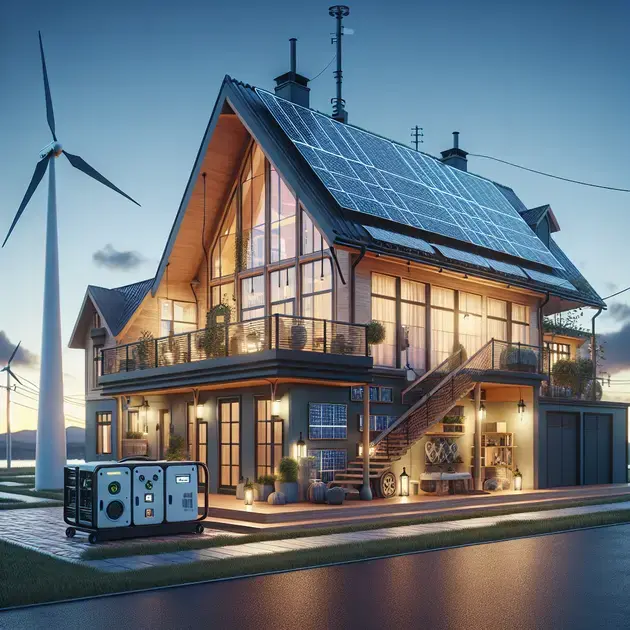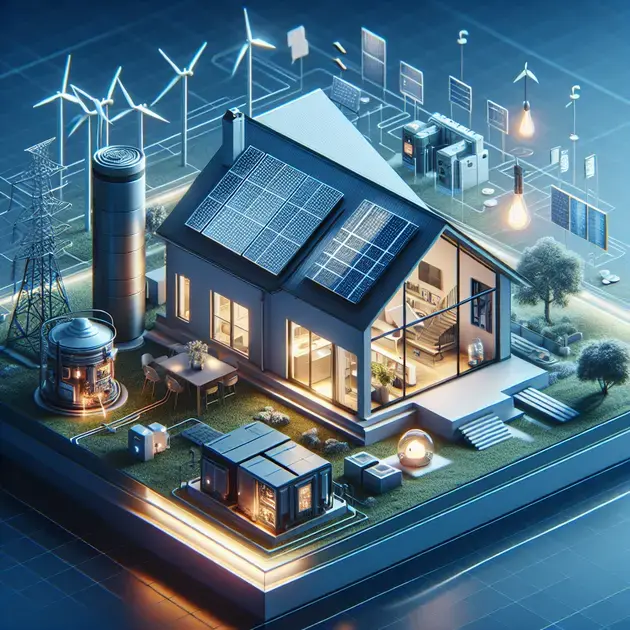When it comes to generating electricity, one efficient solution for powering your home is through an electricity generator. As we strive for more sustainable energy sources, many homeowners are turning to generators as a reliable way to keep their households powered up, especially during outages or in off-grid locations.
With the advancements in generator technology, there are now choices that offer increased efficiency, lower emissions, and the ability to integrate with renewable energy sources. In this blog post, we will explore the options available for powering your home with an electricity generator and how you can make the most out of this alternative energy solution.
How Electricity Generators Work
Introduction
Electricity generators are devices that convert mechanical energy into electrical energy. They play a crucial role in providing power during outages or in off-grid locations. Understanding how electricity generators work can help you appreciate their importance and make informed decisions when choosing one for your needs.
Working Principle
Electricity generators operate based on the principle of electromagnetic induction. A magnetic field is created by rotating coils within the generator, which then induces a flow of electric current in the coils. This current is what gets converted into usable electricity for various applications.
Types of Generators
There are different types of electricity generators, including diesel, gasoline, propane, and solar-powered generators. Each type has its pros and cons, depending on factors such as fuel availability, power output, and environmental impact. It’s essential to choose the right type based on your specific requirements.
Maintenance and Safety
Proper maintenance of electricity generators is crucial to ensure their efficient and safe operation. Regular checks on fuel levels, oil changes, and servicing are necessary to prevent malfunctions. Additionally, following safety protocols, such as keeping the generator outdoors and away from living areas, is essential to avoid carbon monoxide poisoning.
Conclusion
Understanding how electricity generators work is the first step towards harnessing their benefits. Whether you need backup power for emergencies or a reliable source of electricity off-grid, choosing the right generator and maintaining it properly will ensure a steady supply of electrical energy when you need it the most.
Choosing the Right Generator for Your Home
Evaluating Power Requirements
Before selecting a generator for your home, calculate the total power consumption of essential appliances and devices. Websites like Generac’s generator sizing calculator can help you determine the wattage needed to keep your household running during outages.
Fuel Type and Availability
Consider the availability of fuel sources in your area when choosing a generator. Gasoline generators are common but may not be practical for long outages. Propane and diesel generators are alternative options that offer longer run times and are often more efficient.
Portability and Installation
Depending on your needs, you may opt for a portable generator that can be moved around or a standby generator that stays in one location. Websites like Home Depot provide information on installation requirements and the portability of different generator models.
Cost and Budget
Generators come in a range of sizes and prices, so consider your budget when selecting the right one for your home. Websites like Lowe’s offer a variety of generators with different features and price points to fit your financial constraints.
Warranty and Support
When purchasing a generator, look for brands that offer reliable warranties and customer support. Researching customer reviews on websites like Amazon can give you insights into the durability and service quality of various generator models.
Integrating Renewable Energy Sources
Solar Power Integration
Integrating solar panels with a backup generator can enhance your home’s energy efficiency and reduce reliance on non-renewable fuels. Websites like Tesla’s Solar Roof configurator can help you design a custom solar power system that complements your generator setup.
Wind Power Options
For locations with consistent wind patterns, installing a small wind turbine alongside a generator can further diversify your energy sources. Websites like WindEnergy7 provide information on residential wind turbine options and their integration with existing power systems.
Battery Storage Solutions
Pairing a generator with a battery storage system allows you to store excess power generated during periods of low demand. Websites like Goal Zero offer portable battery solutions that can be integrated with generators to create a more resilient and sustainable power setup.
Grid-Tied Systems
Consider connecting your generator and renewable energy sources to the grid through a grid-tied system. Websites like SolarEdge offer products that enable you to feed excess power back into the grid, reducing your overall energy costs and environmental impact.
Smart Energy Management
Incorporating smart energy management systems, such as those offered by Nest or Ecobee, can optimize the use of renewable energy sources and generators. These systems help monitor and control energy consumption, ensuring efficient utilization of available power resources.
Maximizing Energy Efficiency in Your Home
When it comes to maximizing energy efficiency in your home, there are several steps you can take to reduce your energy consumption and lower your utility bills. One effective way is to ensure that your home is well insulated, which helps trap heat in the winter and keep it out in the summer. By properly insulating your walls, attic, and floors, you can prevent heat loss and reduce the strain on your HVAC system.
Another important aspect of energy efficiency is upgrading to energy-efficient appliances and lighting. Look for appliances with the Energy Star label, as they are designed to use less energy while still providing high performance. Switching to LED light bulbs can also make a significant impact on your energy usage, as they consume less electricity and last longer than traditional incandescent bulbs.
Implementing a programmable thermostat is another effective way to maximize energy efficiency in your home. By setting your thermostat to adjust the temperature based on your schedule, you can avoid heating or cooling an empty house and reduce energy waste. Additionally, regular maintenance of your HVAC system, such as changing air filters and scheduling tune-ups, can ensure that it operates efficiently and prolong its lifespan.
Considering renewable energy sources like solar panels or wind turbines can also help you maximize energy efficiency in your home. By generating your own clean energy, you can reduce your reliance on traditional power sources and potentially even earn credits for excess energy produced. Investing in energy-efficient windows and doors can further improve your home’s insulation and reduce drafts, helping you save even more on your energy bills.
Installing and Maintaining Your Generator System
When it comes to installing and maintaining a generator system in your home, proper planning and regular upkeep are essential to ensure reliable backup power during outages. The first step is to determine the appropriate size and type of generator for your home’s needs, whether you opt for a portable generator or a standby generator that automatically turns on when the power goes out.
Before installing a generator system, it’s crucial to consult with a professional to assess your electrical needs and ensure compliance with local codes and regulations. Proper installation by a certified electrician is key to safety and efficiency, as incorrect setup can lead to equipment damage or even safety hazards.
Once your generator system is installed, regular maintenance is vital to keep it in optimal condition. This includes scheduling routine inspections, testing the system, and replacing any worn-out parts as needed. Keeping a supply of fuel on hand and following proper storage guidelines are also important aspects of generator maintenance to ensure it operates smoothly when needed.
During power outages, it’s essential to follow safety protocols when using a generator, such as placing it outdoors in a well-ventilated area away from windows and vents to prevent carbon monoxide poisoning. It’s also recommended to use a transfer switch to safely connect the generator to your home’s electrical system and avoid backfeeding power to utility lines.
By following these installation and maintenance tips, you can ensure that your generator system is ready to provide backup power when necessary and operate safely and efficiently for years to come.
Tips for Safe and Effective Electricity Generation
When it comes to safe and effective electricity generation, whether through conventional means or renewable sources, there are important considerations to keep in mind to ensure both reliability and sustainability. One key tip is to prioritize safety measures, such as wearing appropriate protective gear and following proper procedures when working with electrical equipment or power sources.
Regular inspections and maintenance of electrical systems are crucial in identifying potential issues early and preventing hazards. Checking for loose connections, frayed wires, or signs of wear and tear can help avoid electrical failures and reduce the risk of electrical fires or shocks.
Utilizing energy-efficient practices, such as turning off lights and appliances when not in use, can help conserve electricity and reduce your overall energy consumption. Implementing smart energy solutions, like using power strips to easily turn off multiple devices at once or investing in energy monitoring devices, can also aid in optimizing your electricity usage.
When considering renewable energy generation, such as installing solar panels or wind turbines, it’s essential to consult with professionals to assess your property’s suitability and maximize energy production. Proper installation and maintenance of renewable energy systems can ensure their longevity and efficiency in generating clean electricity for your home.
Lastly, staying informed about energy-saving technologies and practices can help you make informed decisions about electricity generation and consumption. By incorporating these tips into your daily routine, you can contribute to a safer, more sustainable energy future while optimizing your electricity generation efforts.
Conclusion
Maximizing energy efficiency in your home is crucial for reducing energy consumption and lowering utility bills. By ensuring proper insulation, upgrading to energy-efficient appliances and lighting, implementing a programmable thermostat, and considering renewable energy sources, you can significantly improve your home’s energy efficiency.
When it comes to installing and maintaining a generator system, proper planning, consultation with professionals, and regular upkeep are essential for reliable backup power during outages. Following safety protocols, performing routine maintenance, and using a transfer switch can ensure your generator operates safely and efficiently for years to come.
For safe and effective electricity generation, prioritizing safety measures, regular inspections, and utilization of energy-efficient practices are key. By staying informed about energy-saving technologies and incorporating smart energy solutions, you can contribute to a safer, more sustainable energy future while optimizing your electricity generation efforts.

